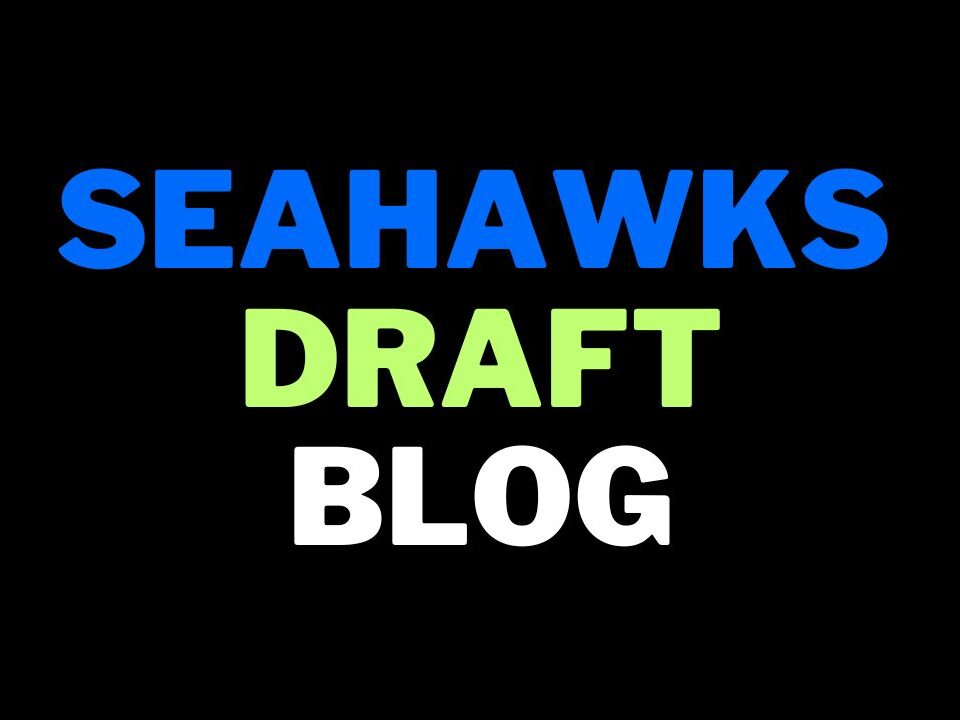The Seahawks are 0-4-1 on the road vs the NFC. In the past they’ve been veritable road warriors during the Russell Wilson era.
Not in 2016.
A physical running game and a stingy defense travels well. The Seahawks, this year, are like a lot of other teams. They’re relying on their passing game. On the road in a tough, noisy environment — it doesn’t take much to knock a passing game out of sync. Then you’re chasing the game. Then you’re at a disadvantage.
There’s a reason why in the five road games vs NFC opponents, Seattle is averaging 8.5 points a game. That includes the Earl Thomas pick-six vs New Orleans and the two-point safety in Tampa Bay.
Getting back to the brand of football that travels well and served this team until the back end of 2015 could be a focus in the off-season. That means getting a tone-setter at running back and finding a way to replenish the defense.
Here’s a scenario that will divide opinion. And let me stress — this is a talking point. I’m not arguing the Seahawks should, will or could do this. I’m trying to take our minds off the Green Bay meltdown.
In Todd McShay’s first 2017 mock draft today he had Leonard Fournette going #7 overall to Carolina. Fournette is exactly the type of running back you need to set the tone on the road. A 6-1, 235lbs monster. He seeks contact, runs over defenders, pounds it up the gut and is still capable of hitting a home run.
Even though McShay has him falling to #7, he still had this to say:
“Fournette hasn’t budged from the No. 1 spot in my prospect rankings all season. He is a rare talent for the position, the best college running back I’ve evaluated since Adrian Peterson in 2007.”
Fournette and Myles Garrett will be competing to be #1 on most draft boards. The Seahawks reportedly ranked Todd Gurley as the best player in the 2015 draft. Fournette is better and isn’t recovering from a torn ACL.
It is going to be impossible to find another Marshawn Lynch. Fournette is a very different body type to Lynch, but in terms of attitude and physical presence he might be as close as you’ll ever come.
McShay has the Jets picking at #6. They might be open to trading with a NFC team. New York has had a miserable season and they’re in need of a major rebuild. They need young talent to replace the ageing core they have (Brandon Marshall, Ryan Fitzpatrick, Darrelle Revis etc).
In 2011 the Atlanta Falcons moved from #26 overall to #6, making a deal with another AFC team, Cleveland, looking to acquire multiple picks during a rebuild. They moved up to get Julio Jones.
The trade cost Atlanta the #26 overall pick, their second round pick (#59) and their fourth round pick (#124). The Falcons also traded their 2012 first round pick and another fourth rounder.
The Seahawks would need to give up something similar to move up for Fournette using McShay’s mock as an example. Could they justify such a move?
Seattle’s roster is pretty much set. It’s arguably the most talented roster in the NFL. What it’s lacking is a consistency. It’s missing elements that were vital to the core philosophy of the team in 2013 and 2014 (physical running game).
Sacrificing two first round picks for one player is always a risk. That said, it’s not like the Seahawks have had a great deal of success picking early over the years:
2011 — James Carpenter, John Moffitt
2012 — Bruce Irvin, Bobby Wagner
2013 — Percy Harvin (trade), Christine Michael
2014 — Paul Richardson, Justin Britt
2015 — Jimmy Graham (trade), Frank Clark
2016 — Germain Ifedi, Jarran Reed
By trading for Fournette you might be missing out on another quality player like Wagner. You also might only be giving up the chance to select three players similar to James Carpenter, Christine Michael and Paul Richardson.
The Seahawks are expected to receive a third round compensatory pick again this year. That would limit the 2017 damage to the teams draft stock. They don’t own a fourth rounder (traded to New England for Quinton Jefferson a year ago) but from next year teams are allowed to deal compensatory picks for the first time. So while they would be surrendering a first, second and compensatory third rounder in 2017 — they would still pick twice in the first two days of the draft.
Such a deal would make it difficult to address both the key defensive need and add further competition to the O-line. It would likely be dependant on a free agent splash for an interior defensive lineman. As discussed yesterday — there could be some options. The Seahawks will have around $38-40m to spend with the cap potentially increasing to as much as $170m overall.
Kawann Short, Calais Campbell and Dontari Poe stand out as possible free agents. Carolina and Arizona both have significant cap room to retain Short and Campbell but Kansas City, at the moment, are scheduled to be just $4m in the black for 2017. With a big contract extension for Eric Berry expected to be their priority — there’s a strong possibility Poe hits the open market.
There will likely be alternative options too.
Campbell might be more likely to be available if the Cardinals decide to get younger and reshape their roster after a down year. They do also have to pay Chandler Jones.
In terms of offensive tackles, they might be able to target someone like USC’s Chad Wheeler at the back of day two or during day three.
The plan would be to acquire a veteran interior defensive lineman in free agency, trade up Fournette and still come away with an O-liner you can work with (Wheeler?) and potentially leave yourself with the draft capital to target someone like Shalom Luani.
It’s fanciful. It’s unrealistic. It’s crazy, zany and unlikely. It probably won’t happen. Just like the trades for Jimmy Graham and Percy Harvin…
This would be an extremely aggressive off-season for the Seahawks — but they are right in the middle of a Championship window. Isn’t this the time to be aggressive?
Some will love this idea. Others would prefer the Seahawks keep their picks and maybe target other running backs to address this need. Maybe a D’Onta Foreman or a Samaje Perine for example.
That’s a very sound, logical stance to take. But Fournette has the potential to be special. He can be that generational, unique talent. Adrian Peterson, Marshawn Lynch. Fournette is made from the same material.
Looking at McShay’s mock
If you have an ESPN Insider account you can see it in full here. I’m going to post my own mock below and then compare it to McShay’s to see which players are available to the Seahawks that weren’t in mine.
Rob’s mock…
1. Browns — Myles Garrett (EDGE, Texas A&M)
2. 49ers — Mitch Trubisky (QB, North Carolina)
3. Jaguars — Leonard Fournette (RB, LSU)
4. Bears — Jonathan Allen (DE, Alabama)
5. Jets — Jabrill Peppers (S, Michigan)
6. Titans (via Rams) — Reuben Foster (LB, Alabama)
7. Panthers — Jamal Adams (S, LSU)
8. Saints — Tim Williams (EDGE, Alabama)
9. Browns (via Eagles) — Dalvin Cook (RB, Florida State)
10. Chargers — Malik Hooker (S, Ohio State)
11. Cardinals — Marlon Humphrey (CB, Alabama)
12. Bengals — Takkarist McKinley (EDGE, UCLA)
13. Colts — Garett Bolles (T, Utah)
14. Bills — O.J. Howard (TE, Alabama)
15. Titans — Sidney Jones (CB, Washington)
16. Ravens — Demarcus Walker (DE, Florida State)
17. Eagles (via Vikings) — John Ross (WR, Washington)
18. Packers — Quincy Wilson (CB, Florida)
19. Washington — Zach Cunningham (LB, Vanderbilt)
20. Dolphins — Jalen Tabor (CB, Florida)
21. Texans — Justin Evans (S, Texas A&M)
22. Buccaneers — Adoree’ Jackson (CB, USC)
23. Broncos — Malik McDowell (DE, Michigan State)
24. Falcons — Budda Baker (S, Washington)
25. Steelers — Deshaun Watson (QB, Clemson)
26. Seahawks — ????
Players available to Seattle in McShay’s mock that weren’t in mine
Mitch Trubisky (QB, North Carolina)
Malik Hooker (S, Ohio State)
Garett Bolles (T, Utah)
Sidney Jones (CB, Washington)
Demarcus Walker (DE, Florida State)
Zach Cunningham (LB, Vanderbilt)
Justin Evans (S, Texas A&M)
Adoree’ Jackson (CB, USC)
Budda Baker (S, Washington)
Deshaun Watson (QB, Clemson)
Players available in both mocks
Obi Melifonwu (S, Connecticut)
Tre’Davious White (CB, LSU)
Deshone Kizer (QB, Notre Dame)
Christian McCaffrey (RB, Stanford)
Solomon Thomas (DE, Stanford)
Derrick Nnadi (DT, Florida State)
Jake Butt (TE, Michigan)
Cam Sutton (CB, Tennessee)
Marcus Maye (S, Florida)
Dorian Johnson (G, Pittsburgh)
Alex Anzalone (LB, Florida)
Evan Engram (TE, Ole Miss)
Dan Feeney (G, Indiana)
Ryan Anderson (LB, Alabama)
Lowell Lotulelei (DT, Utah)
Bucky Hodges (TE, Virginia Tech)
Chris Wormley (DT, Michigan)
Samaje Perine (RB, Oklahoma)
Dawuane Smoot (EDGE, Illinois)
Elijah Qualls (DT, Washington)
Josey Jewell (LB, Iowa)
Dalvin Tomlinson (DT, Alabama)
Haason Reddick (LB, Temple)
Obviously the name that stands out is Garett Bolles. McShay doesn’t include him in the first round, possibly because he hasn’t declared yet. If he turns pro he should find a home in the top-20.
Demarcus Walker is another player available in McShay’s mock. His versatility, size, repertoire, technique and production would be very intriguing. He is listed at 280lbs so could play inside/out. That might be a little generous.
The likes of Derrick Nnadi are there, plus big names and likely top-25 picks Zach Cunningham, Sidney Jones, Justin Evans and Adoree’ Jackson.
So if the Seahawks don’t pull off any bold trades — these two mocks show there will be plenty of options for Seattle. The question is — is now the time to make a splash? Is this team at a point where a bold move can be justified?
McShay’s pick for Seattle is Notre Dame left tackle Mike McGlinchey:
McGlinchey has held firm that he’s likely to return to school, but for now he’s eligible. While he’d benefit from one more year of physical development and technique work, an OT-needy team such as the Seahawks would give McGlinchey a long look because of his length and upside if he decided to leave early.
It’ll be interesting to see if Deshone Kizer’s decision to turn pro influences McGlinchey to make a similar decision.

